A detailed review and performance comparison of the Scott Radian, Sage X and G.Loomis Asquith

The fast action fly rod market has been defined by three rods: the Scott Radian, Sage X and G.Loomis Asquith. In almost any process of selecting a top quality power-oriented trout rod, one or all of these enters the pool of consideration. In many cases, anglers quickly reduce their choice to one of these three and, logically, want to know as much as possible about how the specific models compare with each other.
This is our side-by-side evaluation of the most popular models in each series, as well as notes about how each series and individual model evolved from its predecessor. Many Telluride Angler staff weighed in, but the entirety of the casting and comparison process was done by John Duncan and Richard Post, on a mission to understand the fine points of differentiation between these wonderful fly rods and help anglers choose the best rod for their own fishing. We name our favorite models in each series, but withhold from ranking the rods in overall quality. By offering detailed comparisons, we hope to provide the angler with references to make his or her own choice. Fly fishing, after all, is a sport of preferences.
Scott Radian
Since the introduction of the STS Series in 1995, Scott has offered two action classes of freshwater fly rods, medium and fast. The famous Scott G Series has firmly satisfied the need for an all-around trout rod with a classic, versatile action. These rods remain enormously popular today, but Scott’s mission to offer a fast action trout rod of equal quality has been an up and down road. The STS, Eclipse and S3 series each contained fine individual models, but fell short of the grand mission. The S4, introduced in the late 2000s, was an unequivocal success, proving that Scott could make a broad series of fast action rods that were light in hand, sweet casters at medium and long distances and durable under heavy use. The Radian, introduced in 2013, was conceived as the defining fast action rod. If the S4 was a call to attention, the Radian was the final word: if you need a serious fast action fly rod, Scott has the stick. In this regard, however, the Radian was designed as a specialized fly rod for power fishing situations, a complement to the G rather than a rod that most anglers would consider as their all-arounder. It has turned out to be one of the most popular fly rods of all time, used and loved by anglers in every imaginable fishing situation, but it is important to understand that the Radian is Scott’s entry to the fast action (or super-fast action) category. It is fundamentally different than any previous Scott fly rod: lighter, stiffer, more stable and accurate at distance.
Defining characteristics of Radian: lightness, power and superb stability/control
Best models: R 854-4, R 905-4, R 906-4
Sage X
 Sage has owned the fast action fly rod market in the last 30 years. In fact, they have introduced so many fast action rods as to create a need for distinction. In recent years, the ONE and Method were offered alongside each other. These two fly rods were too similar in action, both very stiff in the judgement of most anglers, the Method being the stiffer of the two. In the summer of 2016, Sage replaced the ONE with the X Series, a rod that is considerably less stiff than the Method and more versatile than the ONE. The Sage X has a generalized action for versatile purposes, rather than a specialized fast action rod for extreme conditions. Shortly thereafter, Method was replaced by Igniter. If the Igniter is a 10 out of 10 in stiffness, the ONE is an 8.5 and the X perhaps a 7.5 or 8. ONE rods tend to cast best off the tip, but X rods flex evenly throughout the blank, affording the angler much greater loop control and effective casting both short and long. Anglers who prefer fast action rods find that the X fishes great in every situation, not just windy days on big water. X rods are tolerant of a wide range of fly lines whereas ONE rods are highly sensitive to line pairings. For Sage, the X is the first fly rod recommended for almost any angler.
Sage has owned the fast action fly rod market in the last 30 years. In fact, they have introduced so many fast action rods as to create a need for distinction. In recent years, the ONE and Method were offered alongside each other. These two fly rods were too similar in action, both very stiff in the judgement of most anglers, the Method being the stiffer of the two. In the summer of 2016, Sage replaced the ONE with the X Series, a rod that is considerably less stiff than the Method and more versatile than the ONE. The Sage X has a generalized action for versatile purposes, rather than a specialized fast action rod for extreme conditions. Shortly thereafter, Method was replaced by Igniter. If the Igniter is a 10 out of 10 in stiffness, the ONE is an 8.5 and the X perhaps a 7.5 or 8. ONE rods tend to cast best off the tip, but X rods flex evenly throughout the blank, affording the angler much greater loop control and effective casting both short and long. Anglers who prefer fast action rods find that the X fishes great in every situation, not just windy days on big water. X rods are tolerant of a wide range of fly lines whereas ONE rods are highly sensitive to line pairings. For Sage, the X is the first fly rod recommended for almost any angler.
Defining characteristics of X: range, loop control and exceptional feel for a fast action rod
Best models: 590-4 X, 597-4 X, 896-4 X
G.Loomis Asquith
 Like Sage, Loomis has earned their reputation on fast action rods. In the NRX Series, Rajeff introduced “Light Presentation” models as moderate action counterparts for the 9’ 4-weight and 9’ 5-weight. These are well designed fly rods that have tempered the Loomis reputation as a one trick pony, but from one generation of rods to the next, almost all G.Loomis trout rods would qualify as “fast action.” Rajeff has generally been patient in pushing out new technology. Each generation of fly rod has offered concrete improvements over its predecessor. The GLX added power to the IMX. The NRX lightened the GLX by some 20%. Now, the Asquith has lightened and stabilized the NRX in a range of models that is, without exception, higher in quality and more cohesive as a group. The Asquith has been introduced concurrently with the NRX and GLX in the Loomis lineup. It comes at a premium price and is clearly the flagship fly rod for the company. The Asquith is not a new kind of fly rod for Loomis (as the Radian is for Scott). It represents everything we love about classic Loomis rods, only better.
Like Sage, Loomis has earned their reputation on fast action rods. In the NRX Series, Rajeff introduced “Light Presentation” models as moderate action counterparts for the 9’ 4-weight and 9’ 5-weight. These are well designed fly rods that have tempered the Loomis reputation as a one trick pony, but from one generation of rods to the next, almost all G.Loomis trout rods would qualify as “fast action.” Rajeff has generally been patient in pushing out new technology. Each generation of fly rod has offered concrete improvements over its predecessor. The GLX added power to the IMX. The NRX lightened the GLX by some 20%. Now, the Asquith has lightened and stabilized the NRX in a range of models that is, without exception, higher in quality and more cohesive as a group. The Asquith has been introduced concurrently with the NRX and GLX in the Loomis lineup. It comes at a premium price and is clearly the flagship fly rod for the company. The Asquith is not a new kind of fly rod for Loomis (as the Radian is for Scott). It represents everything we love about classic Loomis rods, only better.
Much better.
Defining characteristics of Asquith: “airy” lightness, ease of casting, line speed at any distance
Best models: ASQ 490-4, ASQ 790-4, ASQ 1190-4
Note on Line Pairings: These reviews were written after casting every rod with multiple lines. At the trade show, Loomis had SA Trout tapers on all the trout Asquiths and SA Bonefish tapers/Tarpon tapers on the saltwater models. Sage had Rio Perceptions on X models up through the 8-weight. In 2013, we did a lot of experimenting on the Radian and found the Rio Gold to be our predominant favorite. Here in the shop, we re-cast them all with a Rio Gold. On our individual model reviews (on the specific fly rod pages), we recommend one or more specific fly lines for each rod.
Model-by-Model Comparisons
Sage X 486-4 vs Scott Radian 854-4
These are both outstanding fly rods. Short fast action rods are hard to design because they operate as a tighter spring and tend to feel stiff and ineffective at short distance. Both rods feel spectacularly light in hand, and even lighter when casting. The X 486-4 flexes more evenly than the Radian and provides a more intuitive connection to the fly line. The Radian has a more defined flex point with an aggressive transition between the tip and the butt section of the rod (like so many Sage rods of the past), but rod designer Jim Bartschi got the flex point just right. Both rods work beautifully at short, medium and longer distances. The Radian is a little more timing sensitive, but also more stable at distance. The X may offer superior loop control for dry fly anglers while the Radian will be slightly better in the wind, at distance and with any kind of non-dry fly rig.
Sage X 490-4 vs Scott Radian 904-4 vs Loomis Asquith 490-4
Two of these rods, the X and Asquith, are quite similar in their tapers and feel. The Radian is much stiffer than either, so it’s easy to distinguish the action of that rod from the other two. The Radian, like the Sage Method, is among the stiffest 9’ 4-weights on the market. We prefer this rod only in aggressive casting situations where wind is a given and large flies a probability. The X and Asquith are both designed as general purpose 4-weights, feather light and lovely to swing. When casting side by side, the X seems to offer greater loop stability, but we can feel the subtle transitions between each section of the rod. The Asquith, on the other hand, has a seamless transition between the four parts of the fly rod. There is perhaps no other trout rod so perfectly tuned to its line weight as the Asquith 490-4. It honestly feels like a 1-piece rod. Sage fans will love the X 490-4, but the Asquith 490-4 may be the single finest new fly rod that we have cast all year. Both the Asquith 490-4 and X 490-4 are well centered in their categories as all-around 4-weights. Neither feels too stiff with a small dry fly, nor too soft for nymphs or modest streamers.
Scott Radian 1004-4 vs Sage X 4100-4
Although highly specialized, these are real gems within their respective series. 10’ 4-weights were popularized in the Czech nymph craze, but have taken hold as core equipment for versatile trout fishing techniques throughout the West. Long trout rods offer so many practical advantages –casting distance, roll casting, line mending, hook setting, line steering , greater reach when deep wading or fishing from a float tube– the trick has been to design them to be light in hand and pleasant to use. When introduced in 2014, the Radian 1004-4 stood completely alone in terms of action and swing weight among 10’ 4-weights. It is now joined by the 4100-4 X, a rod of equal nimbleness and even greater feel. These are both fast action, lightweight 10’ 4-weights. Choose the Radian to err on the side of power and accuracy. Choose the X for sweeter feel and more grace with a dry fly. Either way, you will own a fine 10’ trout rod.
Scott Radian 855-4 vs Sage X 586-4
Like the 8 ½’ 4-weight models, the Radian 855-4 is stiffer than the X 586-4 and has a fast transition between the tip and mid sections, which creates a more defined flex point. The X 586-4 is a little smoother and sweeter, especially with a line of subtle taper such as the SA Trout Taper or Rio Perception. The Radian launches with more authority and should be paired with a somewhat more aggressive line, like the SA MPX. The Radian 855-4 is an excellent choice for fishing hoppers, stoneflies and other wind resistant dry flies that benefit from a heavy headed line. This length and line weight is very popular and effect for fishing terrestrials in the eastern United States and Southern Rockies, where medium and smaller sized rivers are the main canvas for our sport. The 586-4 X offers greater loop control, because the rod flexes evenly with varying lengths of line, always recovering quickly for terrific line speed and tight loops. For some anglers, the 586-4 X may offer greater versatility with dry flies of different size and light nymph rigs. The Radian has a stouter butt section and has advantages with heavier nymphs, streamers and large dry dropper rigs.
Scott Radian 905-4 vs Sage X 590-4 vs Loomis Asquith 590-4
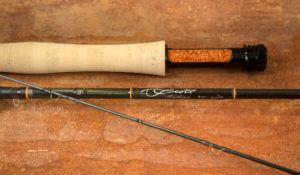 These three rods are compared more than any others on the planet. We will describe them in order of stiffness. The Radian 905-4 is the rod that made this series famous. It is a very fast action rod by any measure, but somehow still casts well at short range. Two unsurpassed characteristics of the Radian 905-4 are 1) unmatched accuracy, especially appreciable at distance and under adverse casting conditions, and 2) more than any other super-fast action fly rod, the Radian 905-4 transmits terrific feel to the palm of your hand. The element of casting control with the Radian 905-4 is #1 of all trout rods we have ever cast. Dropping a dry fly under a branch from 50 feet in the wind feels like placing a salad fork on a napkin. Our favorite line on the Radian 905-4 is the Rio Gold (or InTouch Gold), but this powerful fly rod will easily handle aggressive heads (SA Titan Taper, Rio Grand, etc.) as well as the whole range of sink tips and full sinking lines.
These three rods are compared more than any others on the planet. We will describe them in order of stiffness. The Radian 905-4 is the rod that made this series famous. It is a very fast action rod by any measure, but somehow still casts well at short range. Two unsurpassed characteristics of the Radian 905-4 are 1) unmatched accuracy, especially appreciable at distance and under adverse casting conditions, and 2) more than any other super-fast action fly rod, the Radian 905-4 transmits terrific feel to the palm of your hand. The element of casting control with the Radian 905-4 is #1 of all trout rods we have ever cast. Dropping a dry fly under a branch from 50 feet in the wind feels like placing a salad fork on a napkin. Our favorite line on the Radian 905-4 is the Rio Gold (or InTouch Gold), but this powerful fly rod will easily handle aggressive heads (SA Titan Taper, Rio Grand, etc.) as well as the whole range of sink tips and full sinking lines.
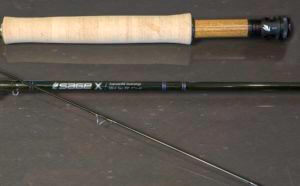
The Sage X 590-4 is a classic fast action rod, but not as stiff as the Radian. Virtually everyone will pick up this rod and cast it well on the first swing thanks to its supremely even flex profile. It may be outdistanced by the Radian 905-4, but the X offers the best loop control of any rod in its class. The first thing everyone says when casting the 590-4 X for the first time is, “Wow, look at those loops.” By default, this rod throws the tightest, most consistent loops of any fly rod we have ever cast. We have also found that it is easy to vary the width and shape of the loop, whether swinging wide to accommodate a nymph/indicator rig or tomahawking a wedge to turn over a long leader in the wind. The 590-4 X also has an extraordinary tolerance for line pairings.
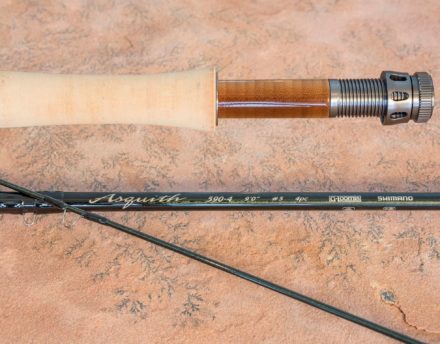 The G.Loomis Asquith 590-4 is an enigma. It is definitely a chip off the same block as the extraordinary ASQ 490-4 and ASQ 790-4, but seems more sensitive to line pairings. With an SA Trout Taper, the rod lacks a bit of the magic of the 4 and 7-weights. Paired with a Rio Gold, however, the Asquith 590-4 feels almost identical to the 4-weight. The all-around fishing functions of this rod are superb. As much as any other rod in the series, the ASQ 590-4 illustrates the benefits of fast and medium-fast action fly rods. Our best descriptors may be “versatile,” “useful,” “rangy” and dependable. With a Rio Gold, we would add “amazing” to this list, but the angler who chooses the Asquith 590-4 should experiment with line pairings to fine tune the action as desired.
The G.Loomis Asquith 590-4 is an enigma. It is definitely a chip off the same block as the extraordinary ASQ 490-4 and ASQ 790-4, but seems more sensitive to line pairings. With an SA Trout Taper, the rod lacks a bit of the magic of the 4 and 7-weights. Paired with a Rio Gold, however, the Asquith 590-4 feels almost identical to the 4-weight. The all-around fishing functions of this rod are superb. As much as any other rod in the series, the ASQ 590-4 illustrates the benefits of fast and medium-fast action fly rods. Our best descriptors may be “versatile,” “useful,” “rangy” and dependable. With a Rio Gold, we would add “amazing” to this list, but the angler who chooses the Asquith 590-4 should experiment with line pairings to fine tune the action as desired.
In terms of versatility, the action of this rod will give you everything you could possibly want from a fast action 5-weight. It has plenty of backbone for nymphs and streamers. It produces casting loops that are both beautiful and highly manageable. The Asquith 590-4 will turn over very long dry fly leaders because it offers an almost perfect combination of line speed and loop control (with the right fly line). Some 5-weights are “nymphing 5-weights,” others are “dry fly 5-weights,” and still others, like the Method 590-4, are “streamer 5-weights.” This rod does it all with honors.
Sage X 597-4 vs Scott Radian 955-4
The Radian 955-4 has become a go-to stick for both dry fly fishing and high stick nymphing on the West’s most daunting trout streams including the Gunnison, Animas, Colorado, North Platte, Madison and Deschutes. As with the Radian 905-4, anglers are surprised by the sweet feel of this high power fly rod. The 597-4 X is one of the three finest rods in its series. The balance, feel and perfection of the flex profile are simply unsurpassed. Choosing between these rods will cause anglers to do a lot of talking to themselves in bars, closets and other dark places. Where power and control are the ultimatum, we would choose the Radian. For all-around purposes, where the angler may fish a broad range of fly types and sizes, we go with the X. The X is a sweeter pure caster, but the Radian’s stiff butt section is a benefit when you’re casting and manipulating line across heavy water on a river like the Gunnison.
Scott Radian 1005-4 vs Sage X 5101
The Radian 1005-4 is true to the series: very fast with a sweet tip and tremendous stability in the mid and butt sections. This rod likes distance and power, but swings with the deftness of most 9’ rods and will still turn over your leader at 20 or 30 feet. It is an exceptional 10’ trout rod, outclassing its competitors in every comparison. Be advised that this is a pure, power-oriented fly rod, ideal for high sticking big rivers and fishing lakes with full sinking lines. It is not designed for delicate midge presentations from either the shore or a float tube, however. The 5101-4 X casts beautifully at short and medium distance, its progressive action loading and recovering with intuitive rhythm. As the cast lengthens, however, the rod develops a certain “wooden” feel in the lower blank which decreases the sensitivity and control over loop shape. Overall, the 5101-4 X is less stiff than the Radian and would make a better dry fly rod, but the Radian offers superior balance and rewards the caster with greater power and command.
Scott Radian 906-4 vs Sage 690-4 X vs Loomis Asquith 690-4 (+ notes on R 906-4 FB and 691-4 X)
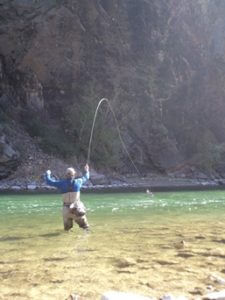 The Radian 906-4 has the most pronounced “tip action” of these three rods. It is the fastest action and best pure power caster, generating terrific line speed and laser loops with masterful control. When casting the Radian 906-4 at distance, the angler knows exactly where the fly will land. The Radian also balances lightest in hand with sensational swing weight. The rod errs on the side of power, however, and lacks the sensitivity found in its 9’ 5-wt cousin. The Radian 906-4 will handle any fly line, including heavy headed Titan and Outbound tapers. Many anglers buy the Radian 906-4 as a streamer rod. Nymph fishermen should use a Rio Grand or specialized nymph line in order to make this rod flex deeper, and to provide more command over your flies on the water.
The Radian 906-4 has the most pronounced “tip action” of these three rods. It is the fastest action and best pure power caster, generating terrific line speed and laser loops with masterful control. When casting the Radian 906-4 at distance, the angler knows exactly where the fly will land. The Radian also balances lightest in hand with sensational swing weight. The rod errs on the side of power, however, and lacks the sensitivity found in its 9’ 5-wt cousin. The Radian 906-4 will handle any fly line, including heavy headed Titan and Outbound tapers. Many anglers buy the Radian 906-4 as a streamer rod. Nymph fishermen should use a Rio Grand or specialized nymph line in order to make this rod flex deeper, and to provide more command over your flies on the water.
Note: The Radian 906-4 FB is built on the same blank as the regular 906-4, but the grip is positioned approximate 3/4″ further up on the blank to accomodate the fighting butt. This stiffens the rod ever so slightly. The 906-4 FB swings lighter than the Radian 906-4 and casts with even more power, but some anglers find this additional muscle pushes the rod toward the 7-weight class.
By comparison, the 690-4 X never feels “stiff” when casting. The tip drives nicely through the cast, but recovers quickly enough to maintain a lively cadence. The 690-4 X feels like it was designed primarily for nymphing, whereas the Radian 906-4’s pure casting qualities suit it for dry flies and streamers more than nymphs. Roll casting and line mending will come easier with the X. Hero casts come from the Radian. Conventional WF line tapers work best on the 690-4 X, including the Rio Gold, Rio Perception, SA Trout Taper and SA MPX. The X 690-4 will handle a Rio Grand, but lines with heavier heads will cause tip bounce and undermine the stability of the mid and butt sections.
Note: The 691-4 X is slightly more oriented toward dry flies and streamers than the 690-4 X. Shifting the grip up the blank to make room for the fighting butt adds a crispness that we really like. Most staff at Telluride Angler recommend the 691-4 X over the 690-4 X for all fishing applications, although we are splitting hairs here.
The Asquith 690-4 is a little slower in action than the 4 and 5-weight Asquith models. It is super smooth, light and easy to cast, but lacks the magic wand feel of the lighter models. The Asquith 690-4 is clearly designed for versatility and will prove equally effective with nymphs, streamers and larger dry flies. It generates a little less line speed than the 691-4 X and lacks the Radian’s overall power and control. Also, we wish this rod had a Wells grip rather than a standard trout taper. The Asquith 690-4 is a terrific rod for fishing salmonflies and large grasshoppers, but won’t throw a streamer with the same authority as an X or Radian. Standard WF tapers, including the SA Trout Taper and Rio Gold, will bring out the best in the ASQ 690-4.
Sage 697-4 X vs Scott Radian 956-4
These two rods measure up similar to the Radian 955-4 and X 597-4. The 697-4 X is not quite as sweet as the 597-4 X, but that’s more a comment on the latter rod. The former is a highly practical nymphing stick, slightly hinged about 1/3 of the way down from the tip so as to create a feeling of “follow through” on every cast. This is a great open loop caster, ideal for nymphs rigged with an indicator at awkward distance from the flies. The X 697-4 is an excellent roll caster and line mender, critical techniques for the dedicated nympher. It is not great with a streamer and lacks the pure distance casting prowess of the Radian, but a fine high stick nymphing tool.
The Radian 956-4 has a mighty butt section and stable mid parts. It casts off the tip, holding the line high about the water and whatever may lurk behind the caster. The Radian 956-4 excels in long casts, high backcasts and lifting a long line. This is a rod for burly rivers, large flies and heavy fish. It offers surprising feel for its stiffness, but can’t match the 697-4 X for mending touch. On big water, however, the Radian really shines. The sheer authority of the Radian 956-4 makes it the default “heavy rod” choice for nymphs, streamers and even large dry flies in the Black Canyon of the Gunnison and other similar environments.
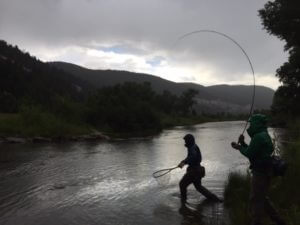 Loomis Asquith 790-4 vs Sage X 790-4 vs Scott Radian 907-4
Loomis Asquith 790-4 vs Sage X 790-4 vs Scott Radian 907-4
7-weights are definitely the new 8-weights. From the Bahamas to the Great Lakes to Christmas Island and Kamchatka, 7-weights are becoming the go-to fly rod. Loomis does not differentiate between freshwater and saltwater rod models. The Asquith 9’ 4-wt is obviously a trout rod and the 11-wt is clearly for saltwater, but the orientation of the 7 and 8-weights is revealed only by casting the rods with both freshwater and saltwater lines to determine their purpose. The answer? Saltwater. There are certainly freshwater fishing scenarios that demand heavy headed lines and aggressive casting techniques in the likeness of flats fishing, but one should not confuse the purpose of the Asquith 7-weight. When paired with a classic saltwater line, such as the SA Bonefish Taper, this is one of the finest saltwater fly rods ever designed. In pure casting, it is in the 99th or 100th percentile of all single handed fly rods. It looks, feels and casts like a 7-weight flats rod.
So too with the 790-4 X. In fact, we first cast the 790-4 X with a Rio Perception and left the casting pond wondering what in the world was wrong. The Sage guys all claimed this was one of their favorite X models, but we couldn’t make the thing bend. The next morning, we cast it again with a Rio Bonefish taper and were just blown away. Like the Asquith 790-4, this rod needs a short, heavy headed line. A Titan or Outbound Taper will load it beautifully, but any standard trout taper will likely underload the rod, resulting in a dearth of line speed and too much false casting. The 790-4 X is a saltwater fly rod of the highest order.
The Radian 907-4 is quite different. Like some of the other Radian models, it has a distinct flex point about 3 feet down from the tip. It is fast action, but not super-fast. Like the 8 and 9-weight Radians, this model has an anodized reel seat and fighting butt, so technically it is designed for either freshwater or saltwater use. Everything about the casting action speaks to freshwater, however. A bonefish 7-weight would cast more off the tip. This rod has a wonderfully natural casting cadence, flexing just deep enough to allow some real loop control and accommodate heavy, wind resistant flies. Ironically, 7-weight freshwater flies tend to be much heavier and bushier than 7-weight saltwater flies. The Radian 907-4 has been our trusted companion for fishing mice in Kamchatka, pike flies throughout the Rockies and size #4 conehead streamers in Argentina. The supple tip and stiff mid-section allow a wide range of techniques, rather than pure straight line casting. Roll casts, line mending and protecting tippet in heavy moving water all come naturally to the Radian 907-4, but it would be inferior to either the 790-4 Asquith or X on a bonefish flat.

[Fly Rods Page]
[Scott Radian Page]
[Sage X Page]
[G.Loomis Asquith Page]
[Sage X on the water video review]
[Scott Radian on the water video review]

